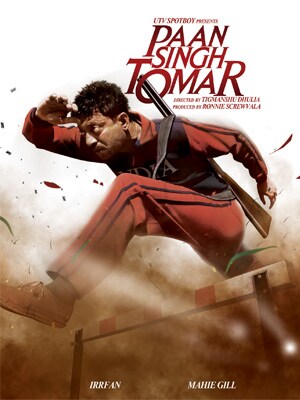
Paan Singh Tomar: Getting it Just Right
The success of Paan Singh Tomar proves that just like in sport, timing is everything in film as well
Film-makers are crazy people. Cinema history is littered with examples of individuals being consumed by their passion, of living in destitution and harbouring that one dream that never saw fruition. But there are also stories of people staggering back from the edge of darkness and surviving, for a time at least. Cue: Francis Ford Coppola with Apocalypse Now and Guru Dutt with Kaagaz Ke Phool.
Now, Tigmanshu Dhulia is not Coppola or Dutt, but the passion, the ‘junoon’ that defined those names burns hard in him. “The story was with me for more than 20 years,” says Dhulia. “I went to many producers asking them to fund the research for the film but I couldn’t convince anyone.” Research was important for the movie. No one knew who Paan Singh Tomar was. He was a name that was revered in the Morena district, Chambal Valley, Madhya Pradesh but that was the extent of his fame.
Then, on the weekend starting March 2, Paan Singh Tomar and PST began trending on microblogging site Twitter. The Twitterverse was agog with adulation for the movie about a national level athlete turned rebel/dacoit. Anurag Kashyap and Shekhar Kapur turned evangelist for Dhulia’s work and announced to all that this was one of the best movies ever made. On March 2, Friday, PST made Rs. 80 lakh. From Friday until Holi, March 8, PST clocked between Rs. 1 crore to Rs. 1.25 crore daily. Made on a budget of a little over a million dollars (Rs. 5 crore) in 2009, the movie turned in a profit within the first week. This was a movie that had succeeded purely on word of mouth marketing.
The amounts involved in PST will not make people sit up and take notice. But the story of PST’s success is important because it defied every stereotype in the Hindi film industry to emerge as a success. Director who has been out of work for seven years: Check. A Hindi dialect that is difficult to understand: Check. Subtitles: Check. Low distribution: Check. A 47-year-old leading man who’s never carried a solo film: Check. A background score out of the 1950s: Check. A film that is released almost two years after it was completed: Check.
Or maybe it succeeded because of all these factors. Only a director who hadn’t worked since 2003 and had nothing to lose would be able to take risks that would make in-work directors hesitate. Only the strength of the character would convince a 47 year-old Irrfan Khan to put his body through a gruelling process to get the physique of a man in his 20s (he broke his ankle while training). The background score haunts the film and yet never intrudes.
Back to the funding now. Dhulia made a pitch to UTV Motion Pictures and they agreed to finance it. “I was sure it would be a very entertaining film,” says Sidharth Roy Kapur, CEO, UTV Motion Pictures. “It’s based in completely contrasting worlds, from the track and field events in Tokyo to the Chambal Valley, and the story is a fascinating account about Tomar’s life. You get a peek into the lives of people who have represented the country in sport and it’s not very good,” says Kapur.
When the film was made, Dhulia felt that it would be something that audiences over 35 years would enjoy. They were surprised when a large chunk of the moviegoers turned out to be youth between 18-35 years.
“It’s a very healthy sign that the general audience is hungry for good entertainment,” says Khan. “Look at the cinema of Guru Dutt, Bimal Roy and Charlie Chaplin. Their films were direct repercussions of what happened in society. PST addresses the angst of the nation in a very endearing way,” he says.
PST may have addressed the angst of the nation but it took an awfully long time to do so. The movie was completed in early 2010 and did the rounds of the international film circuit for a year and a half. After it finished touring the world Kapur and Dhulia waited for the perfect time to release the film. “PST is a film that needs special attention. Every month for the last six months there were 4-5 big releases and that would have killed PST,” says Dhulia.
The film needed to be talked about. But who was going to do the talking? Another thing against PST was that it was released only in 300 screens across the country. Distribution wasn’t great. From all accounts it looked like a film that was made to win awards and get critical acclaim. But then Anurag Kashyap did for PST the same thing that he had for Imtiaz Ali’s Rockstar. He went gaga over it on Twitter. Shekhar Kapur followed. And people started talking. Khan who had never been on Twitter followed their lead and signed up.
Kapur’s explanation of the whole sequence is different. “We couldn’t control word of mouth. We knew we had a good film and we knew we could wait. It was a period film and wouldn’t get dated. And we purposely released it in fewer screens because that’s when occupancy levels would be high (regularly over 70 percent) and that makes people talk. And fewer theatres mean more demand for tickets.” That’s good spin for sure. With the success it has seen in the first week, PST is getting released in 20 more cities in week two.
It’s nice to do the festival circuit and make money too.





